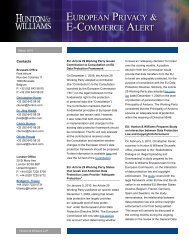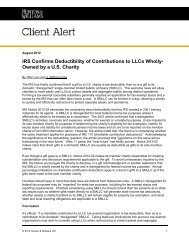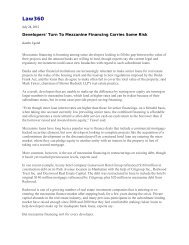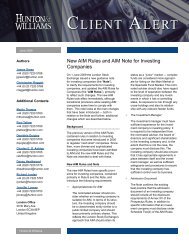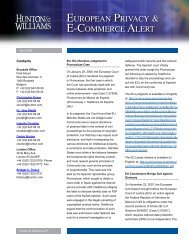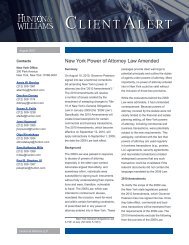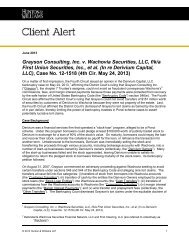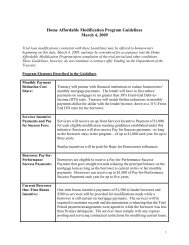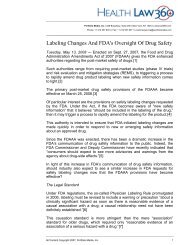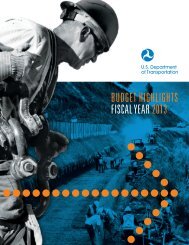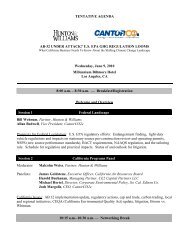Hunton & Williams Renewable Energy Quarterly, September 2009
Hunton & Williams Renewable Energy Quarterly, September 2009
Hunton & Williams Renewable Energy Quarterly, September 2009
You also want an ePaper? Increase the reach of your titles
YUMPU automatically turns print PDFs into web optimized ePapers that Google loves.
<strong>Renewable</strong> <strong>Energy</strong> <strong>Quarterly</strong><br />
whereby it expects to develop 10 GW of installed generating<br />
capacity by 2014. A large portion of this has been set<br />
aside for geothermal power plants. The government will<br />
offer up most of the projects to private investors, and some<br />
projects have already been awarded. This section provides<br />
a brief history of geothermal development and legislation<br />
in Indonesia to date, and describes certain obstacles that<br />
discourage developers from investment.<br />
Abundant Resources, But Limited Development<br />
The Ministry of <strong>Energy</strong> and Mineral Resources (“EDSM”)<br />
has estimated that Indonesia has the geothermal resources<br />
to develop more than 27,000 MW of installed generating<br />
capacity. 5 As of July <strong>2009</strong>, however, just 1,057 MW of<br />
geothermal-based capacity had been developed. 6<br />
Currently government representatives estimate that renewable<br />
energy represents roughly 4.5 percent of Indonesia’s<br />
generation mix (roughly 3 percent being hydro and 1.5<br />
percent being geothermal based). 7<br />
Regulatory Structure<br />
In Indonesia, EDSM is charged with formulating energy<br />
policy. PT Perusahaan Listrik Negara (“PLN”) is the state<br />
power transmission, generation and distribution enterprise.<br />
Geothermal resource development and electricity production<br />
may be undertaken by the public or private sector.<br />
PT Pertamina (“Pertamina”), the state-owned oil and gas<br />
company, has previously acted as the regulator, as well as<br />
a developer, for geothermal exploitation and remains a key<br />
player in the industry.<br />
<strong>Renewable</strong> <strong>Energy</strong> Plans<br />
Indonesia has passed several laws intended to facilitate the<br />
development of renewable energy technologies. A recent<br />
piece of legislation, Presidential Decree No. 5/2006 (the<br />
“<strong>Energy</strong> Plan”), demonstrates Indonesia’s commitment<br />
to develop renewable energy-based power generation.<br />
The <strong>Energy</strong> Plan sets out targets for the energy sector in<br />
2025, namely setting the goal that renewables account for<br />
17 percent of Indonesia’s installed generating capacity (with<br />
5<br />
“Indonesia has 27,000 MW of Potential Geothermal <strong>Energy</strong><br />
Sources.” Antara News. November 12, 2007.<br />
6<br />
“Wayang Windu II Geothermal Powerplant Begins Operation.”<br />
EDSM Press Release. June 22, <strong>2009</strong>.<br />
7<br />
Montty Girianna. “<strong>Renewable</strong> <strong>Energy</strong> and <strong>Energy</strong> Efficiency<br />
in Indonesia.” ADB Workshop on Climate Change and <strong>Energy</strong>,<br />
Bangkok. March 26–27, <strong>2009</strong>: 1.<br />
5 percent to come from biofuel; 5 percent from geothermal;<br />
5 percent from a combination of biomass, hydro, solar, wind<br />
and nuclear; and finally 2 percent from liquefied coal).<br />
Previous Geothermal Program and Geothermal<br />
Legislation<br />
The government has recognized the country’s tremendous<br />
geothermal potential for quite some time. In 1991 the first<br />
geothermal program was introduced by which public and<br />
private enterprises would be allowed to participate in the<br />
development of geothermal-based resource exploitation and<br />
electricity generation. At that time Pertamina was the entity<br />
responsible for managing geothermal resources for the government.<br />
The implementing regulation for the campaign was<br />
Presidential Decree No. 45/1991, by which 11 joint operating<br />
contracts were granted to private developers to exploit as<br />
The Ministry of <strong>Energy</strong> and Mineral<br />
Resources has estimated that Indonesia<br />
has the geothermal resources to<br />
develop more than 27,000 MW of<br />
installed generating capacity.<br />
much as 3,000 MW of geothermal power. Other fields with<br />
estimated capacity of 1,500 MW were allotted to Pertamina<br />
for development. Most projects were derailed by the 1997<br />
Asian financial crisis, and as a result, only a small fraction<br />
of Indonesia’s geothermal potential has been developed to<br />
date.<br />
Each of the projects that was completed operates under<br />
one of two different schemes. The first is that Pertamina or<br />
its joint operation contractor operates the steam production<br />
facility and sells steam to PLN or others that generate<br />
electricity using their own plants. The alternative is that<br />
Pertamina or its joint operation contractors operate both the<br />
steam facility and the power facility, with electricity being sold<br />
off to PLN or others.<br />
Private developers participate by operating the steam<br />
production fields, and in some cases the power generation<br />
facilities, under Joint Operation Contracts with Pertamina as<br />
resource holder. Power is purchased by PLN under dollar-<br />
12 <strong>Renewable</strong> <strong>Energy</strong> <strong>Quarterly</strong> www.hunton.com



